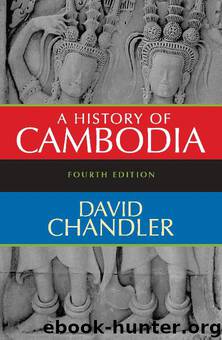A History of Cambodia by David Chandler

Author:David Chandler [DAVID CHANDLER]
Language: eng
Format: epub
Publisher: Westview Press
Published: 2010-12-31T16:00:00+00:00
For these reasons, but primarily to avoid further friction along its border, the Thai decided in 1906 to cede the sruk to France. The French and the Thai signed the final agreement in April 1907, and the sruk came under French control toward the end of the year. Sisowath was not encouraged to visit the area, however, until 1909, for reasons that the chronicle fails to make clear.
And yet the king and his subjects were overjoyed at the restoration of Angkor. In the tang tok ceremonies of October 1907, when officials traditionally offered gifts to the monarch, widely attended celebrations occurred throughout the kingdom to “thank the angels” (thevoda) for the return of the sruk, and local officials assigned to the region came to Phnom Penh to pay homage to the king.
Over the next half century, French scholars and Cambodian workers restored the temples at Angkor. In the long run the restoration was probably France’s most valuable legacy to Cambodia. Battambang, especially in the 1920s, developed into the country’s most prosperous sruk, providing the bulk of Cambodia’s rice exports and sheltering, idiosyncratically, the greatest number of landlords in the country as well as the highest number of immigrants from elsewhere in Cambodia and from the Cambodian-speaking portions of Cochin China.29
By 1909, typewriters had been installed in all the résidences; automobiles came into use on a national scale at about the same time. These two improvements in French administration had several unintentional effects. For one thing, the volume of reports required by résidents, and consumed by their superiors in Phnom Penh, Saigon, Hanoi, and Paris, increased dramatically. Résidents, more than ever, were tied down to their offices, presiding over a two-way flow of paper. They were seldom in contact, socially or professionally, with the people they were paid to supposedly civilize and protect. In automobiles, tours of inspection became speedier and more superficial, for résidents, and their aides were confined to passable roads. In fact, the intensification of French economic and political controls over Cambodia, noticeable throughout the 1920s and after, was accompanied, ironically, by the withdrawal of French officials from many levels of Cambodian life. The government that a Cambodian peasant might encounter in these years was composed of a minority of Cambodians and of a great many Vietnamese brought into the protectorate because they could prepare reports in French, and this interplay between Cambodians and Vietnamese had important effects on the development of Cambodian nationalism, especially after World War II.
Download
This site does not store any files on its server. We only index and link to content provided by other sites. Please contact the content providers to delete copyright contents if any and email us, we'll remove relevant links or contents immediately.
| Arms Control | Diplomacy |
| Security | Trades & Tariffs |
| Treaties | African |
| Asian | Australian & Oceanian |
| Canadian | Caribbean & Latin American |
| European | Middle Eastern |
| Russian & Former Soviet Union |
The Secret History by Donna Tartt(18951)
The Social Justice Warrior Handbook by Lisa De Pasquale(12170)
Thirteen Reasons Why by Jay Asher(8849)
This Is How You Lose Her by Junot Diaz(6837)
Weapons of Math Destruction by Cathy O'Neil(6221)
Zero to One by Peter Thiel(5736)
Beartown by Fredrik Backman(5683)
The Myth of the Strong Leader by Archie Brown(5463)
The Fire Next Time by James Baldwin(5387)
How Democracies Die by Steven Levitsky & Daniel Ziblatt(5175)
Promise Me, Dad by Joe Biden(5117)
Stone's Rules by Roger Stone(5055)
A Higher Loyalty: Truth, Lies, and Leadership by James Comey(4909)
100 Deadly Skills by Clint Emerson(4883)
Rise and Kill First by Ronen Bergman(4741)
Secrecy World by Jake Bernstein(4703)
The David Icke Guide to the Global Conspiracy (and how to end it) by David Icke(4659)
The Farm by Tom Rob Smith(4468)
The Doomsday Machine by Daniel Ellsberg(4452)
